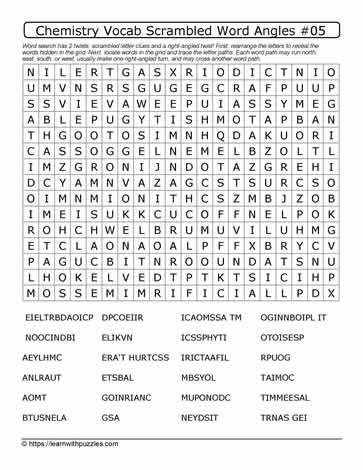Chemistry Vocab Scrambled Wordangle #05( |
Looking for educator resources to activate problem solving skills in students grades 9-12? Here is an academic chemistry vocabulary word angle puzzle that includes word clues with scrambled letters. Most words hidden in the grid have letter paths that include one right hand turn.
Ideas for problem solving:
1. rearrange the scrambled letters in each word clue and record its correct spelling
2. review the complete list of words, before solving the puzzle, to 'engage' the brain
3. locate some of the longer words first, since their letter paths will take up more squares: go from most number of letters to fewest number of letters in the word clues
4. remember that letter paths travel up, down, forwards, backwards; there are no diagonal letter paths
5. trace each letter path of the word clues, and watch for the right hand turn
6. track progress, by checking off the words
7. work with a peer to help solve the puzzle
8. put words in alphabetical order; some students may find this easier to work systematically
9. note that scrambled letter clues do not always represent the number of letters in each multiple word clue. (e.g. 'covalent bond' may be scrambled to look like: 'bnntc vaeolod').
Lesson plan activities:
1. create new word search puzzles [link is below for blank word search grids]
2. create more critical thinking skills activities by having students make connections between this list of chemistry words and elements of the periodic table [periodic table of elements puzzles found here: Chemistry-Periodic Table puzzles]
3. have students collaborate on activity #2 since students learn best by interacting and learning from their peers
4. include the Frayer Model graphic organizer to help consolidate understanding of academic vocabulary
5. record definitions of academic vocabulary
Link to blank word search grids: blank word search grids.
Benefits of puzzles:
1. supports tutoring high school students
2. provides academic chemistry vocabulary building resources
3. supports home school learning environments
4. provides university students with an interactive and engaging review of periodic table vocabulary and elements
5. supports adult brain health

